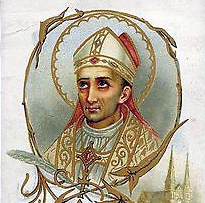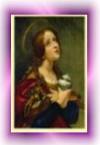The veneration of the Virgin Mary was already established in the Church and Fulbert use this to teach her importance. The results were twofold, it helped to ease people’s fears and greatly expanded the Marian Cult and Chartres’s position in it. Chartres was already involved due to its being the holder of a sacred relic of Mary’s, the “Sancta Camisia”, (Holy Tunic), which has been variously described as being worn by Mary during the Annunciation or during the birth of Christ. This tunic was already the subject of a miracle because of its use by an earlier bishop of Chartres, Gauscelinus, in 911 to ward off the invading Normans. Fulbert expanded on the theme of miracles involving Mary, especially those cases where she had interceded between sinners and God. In this way people could pray for Mary’s intercession with God on their behalf in the perceived coming apocalypse. Fulbert himself was involved in one of these miracles; when he was gravely ill Mary had healed him with a drop of milk because of his devotion to her. This also served to give Mary the image of not only the mother of Christ but for all who believed in her, their mother too. All of this led to Fulbert’s ultimate goal of promoting a special feast day to celebrate Mary’s Nativity.
To gain popular support for this feast, Fulbert wrote his famous sermon “Approbate Consuetudinis” in which he relates Mary’s miracles. He also brings in the evidence of Mary’s family lineage, which the Bible traces back to King David. In his sermon Fulbert used the symbolism of the “Stirps Jesse” (Tree of Jesse) to help explain Mary’s familial relationship to the great men of the past and how it was determined, as described in Scripture, that she would be the one to whom Christ would be born. This again served to enhance her importance to the world and convince people of the need to celebrate her birth. This sermon led to a number of liturgical changes throughout the next few centuries in Europe. The sermon itself, or variations of it and the chants associated with it, became part of the service for the feast day of Mary’s Nativity on 8 September By promoting the Feast day of Mary’s Nativity, Fulbert was able to advance the importance of Mary and therefore the cult of her veneration grew. This in turn enhanced the importance of the Cathedral of Chartres as a centre for Marian devotion and also gave people a spiritual symbol to turn to in times of need at the turn of the millennium.
During his time in Chartres Fulbert played an important role in the development and spread of the ideas that led to the Gregorian church reforms of the eleventh century under Pope Gregory VII. These reforms concerned the division between the powers of church and state, especially in the appointment of new abbots and bishops. In the eleventh century the secular rulers had a habit of appointing whomever they wanted to fill vacant church positions. Fulbert and some of his students, such as Abbot Albert of Marmoutier, routinely wrote that it was up to the clergy and the citizens of the diocese involved to elect a replacement, the authority being found in the rulings of the First Council of Nicaea (325) and the Council of Antioch (264-272). These reforms also stated that the Church, not the state, was responsible for disciplining the clergy. The issues of simony (the buying of church offices) and immoral clerics were also addressed by Fulbert. Although the reforms were issued by Gregory VII, some of its ideas came from Fulbert, whose writings were disseminated through his students.
After Chartres Cathedral burned in 1020, Fulbert devoted his energies to raising funds for its rebuilding, which was completed in 1037, nine years after his death. In 1194 the cathedral was again almost completely destroyed by fire; only the crypt, some of the west facade and two towers remained. The crypt has been incorporated into all subsequent reconstructions. The construction of the Gothic-style cathedral that stands to-day began afterward. It is in this cathedral that we see Fulbert’s influences that resulted from his promotion of the Feast day of Mary’s Nativity and the cult of the Virgin Mary. The sculptures around the three portals depict the life of Mary, who is the central figure in the Royal Portal. One of the cathedral’s stained glass windows depicts the Tree of Jesse, which traces Mary’s family and the Holy Family, again a reference to Fulbert’s teachings in regards to the Feast of Mary’s Nativity.
St Fulbert died of natural causes on April 10, 1029.

